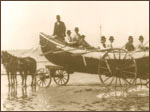| calendar | membership | store | search |

|
| Information | Exhibits | Programs | Races | Events | Get Involved | Home |
| Adults | Families | Children and Teens | Groups | Teacher Resources | Rowing |
|
Tours are available seven days a week, year round, by appointment. To schedule a tour, please call 781-925-5433. We can accommodate a maximum of 50 children at the museum. For groups of more than 25, we will divide the children into 2 tour groups. Tour fees: Groups are invited to picnic on the museum lawn or seawall, or in the loft in case of rain. No food is available for purchase within walking distance of the museum, although there are many eateries along nearby Nantasket Beach. The museum is located at 1117 Nantasket Avenue, Hull, MA. Ample parking is available for cars, vans, and school buses. Directions and pre-tour materials will be mailed with your tour confirmation form. The museum offers the following tours that fall within the Massachusetts State Curriculum Frameworks. Teachers are welcome to contact the museum for more specialized tours.
Point Allerton U.S. Lifesaving Station, constructed in 1889, was home to Captain Joshua James and his crew, America’s greatest lifesavers, renowned for saving hundreds of shipwrecked mariners from peril in Boston Harbor. The tour begins with a brief history of organized lifesaving, emphasizing the contributions of volunteer lifesavers, continues on to the Galley where children learn about daily life at the station, then, on to the Boat Room to see the treasure of the museum collection- the storied surfboat Nantasket. Children will have the chance to view first hand the lifesavers’ surfboat and rescue equipment, while hearing true tales of am azing courage and heroic rescues.
The hands-on fun culminates in the museum’s Loft where children of all ages enjoy “setting sail” on the climb-on boat, dressing up in period clothes, learning to tie a new knot, and standing watch in the museum cupola, with stunning views of Boston Light, Boston Harbor, and Fort Revere Park.
The Breeches Buoy Massachusetts State
Curriculum Frameworks PreK-K.5 Retell stories that illustrate honesty,
courage, friendship, respect, responsibility, and the wise or judicious
exercise of authority, and explain how the characters in the stories
show these qualities. (C) Teachers are free to choose whatever biographies
they wish. 3.8 On a map of Massachusetts, locate the class’s home town or city and its local geographic features and landmarks. (G) 3.9 Identify historic buildings, monuments, or sites in the area and explain their purpose and significance. (H, C) 3.12 Explain how objects or artifacts of everyday life in the past tell us how ordinary people lived and how everyday life has changed. Draw on the services of the local historical society and local museums as needed. (H, G, E) 4.11 Describe the climate, major physical features, and major natural resources in each region (New England coastal geography and climate) 5.11 Explain the importance of maritime commerce
in the development of the economy of colonial Massachusetts, using
the services of historical societies and museums as needed. |
|||||||||||||||
| contact us | © 2004 Hull Lifesaving Museum | |||||||||||||||



